2024届高考英语语法复习:形容词副词课件(共27张PPT)
文档属性
| 名称 | 2024届高考英语语法复习:形容词副词课件(共27张PPT) |  | |
| 格式 | pptx | ||
| 文件大小 | 16.6MB | ||
| 资源类型 | 教案 | ||
| 版本资源 | 通用版 | ||
| 科目 | 英语 | ||
| 更新时间 | 2023-11-19 06:41:15 | ||
图片预览

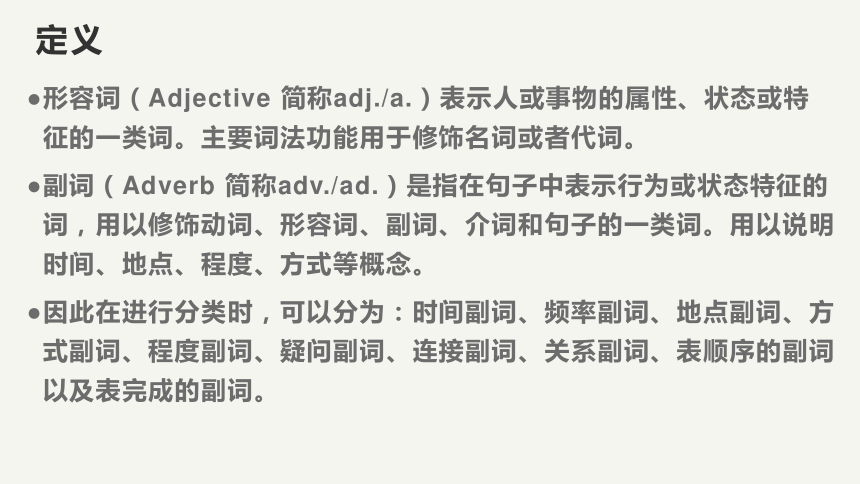
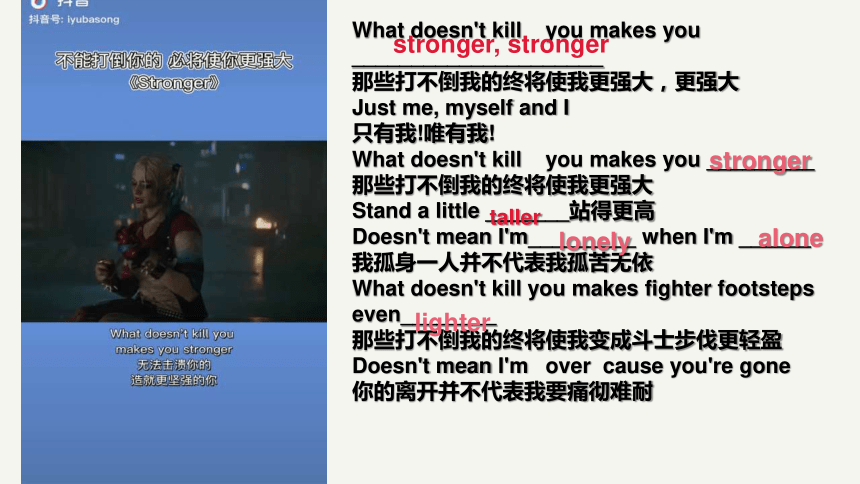
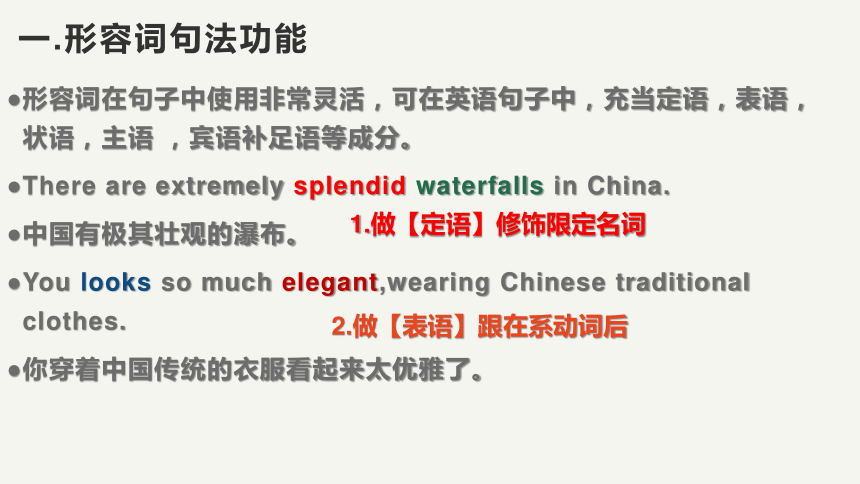
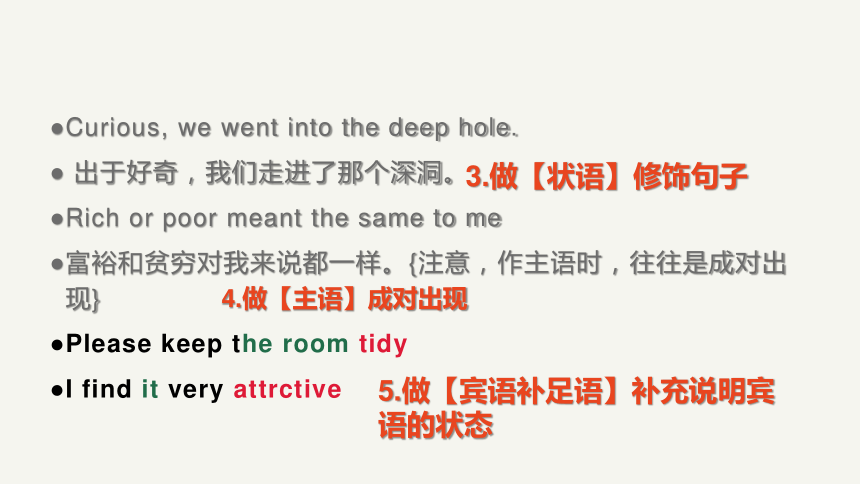
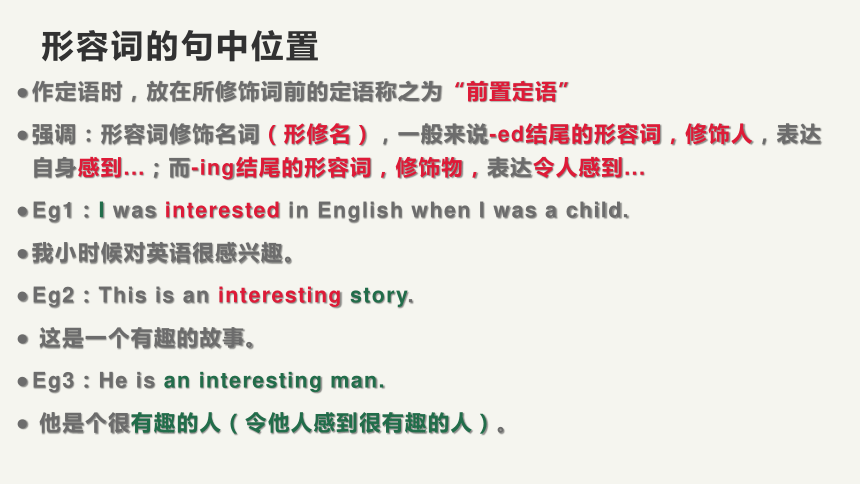
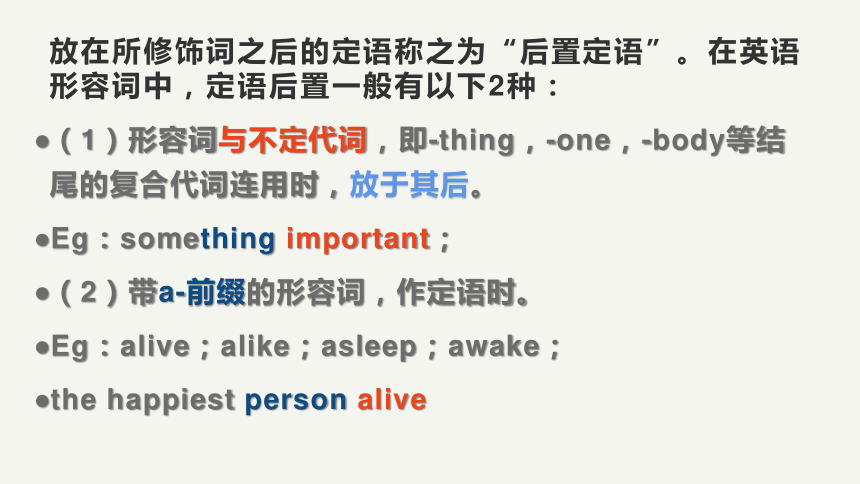
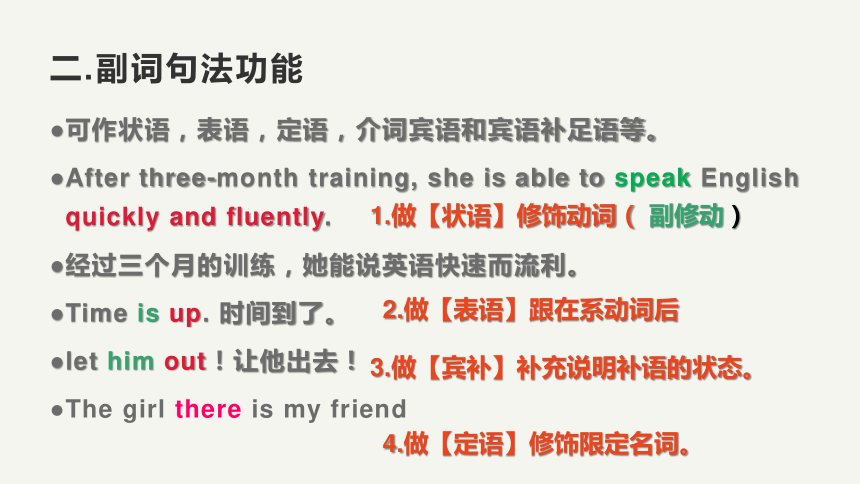
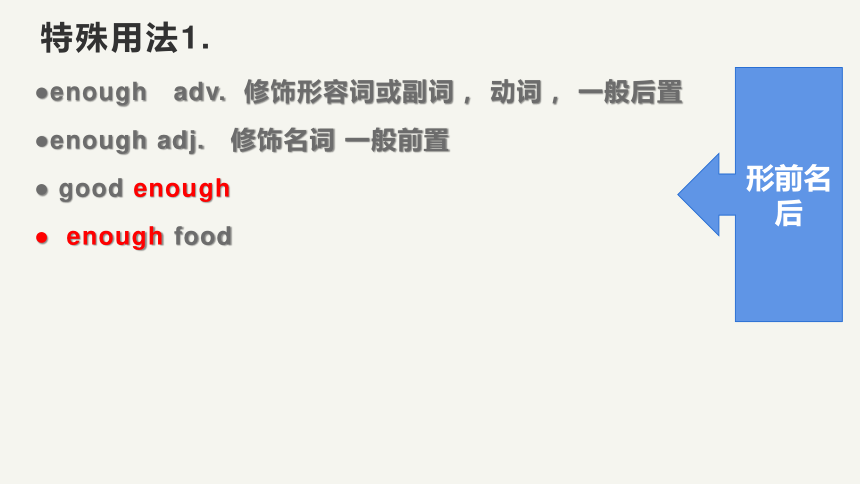
文档简介
(共27张PPT)
形容词和副词1:基础入门
高中英语语法
定义
形容词(Adjective 简称adj./a.)表示人或事物的属性、状态或特征的一类词。主要词法功能用于修饰名词或者代词。
副词(Adverb 简称adv./ad.)是指在句子中表示行为或状态特征的词,用以修饰动词、形容词、副词、介词和句子的一类词。用以说明时间、地点、程度、方式等概念。
因此在进行分类时,可以分为:时间副词、频率副词、地点副词、方式副词、程度副词、疑问副词、连接副词、关系副词、表顺序的副词以及表完成的副词。
What doesn't kill you makes you _____________________
那些打不倒我的终将使我更强大,更强大
Just me, myself and I
只有我!唯有我!
What doesn't kill you makes you _________
那些打不倒我的终将使我更强大
Stand a little _______站得更高
Doesn't mean I'm_________ when I'm ______
我孤身一人并不代表我孤苦无依
What doesn't kill you makes fighter footsteps even________
那些打不倒我的终将使我变成斗士步伐更轻盈
Doesn't mean I'm over cause you're gone
你的离开并不代表我要痛彻难耐
stronger, stronger
stronger
taller
lonely
lighter
alone
一.形容词句法功能
形容词在句子中使用非常灵活,可在英语句子中,充当定语,表语,状语,主语 ,宾语补足语等成分。
There are extremely splendid waterfalls in China.
中国有极其壮观的瀑布。
You looks so much elegant,wearing Chinese traditional clothes.
你穿着中国传统的衣服看起来太优雅了。
1.做【定语】修饰限定名词
2.做【表语】跟在系动词后
Curious, we went into the deep hole.
出于好奇,我们走进了那个深洞。
Rich or poor meant the same to me
富裕和贫穷对我来说都一样。{注意,作主语时,往往是成对出现}
Please keep the room tidy
I find it very attrctive
3.做【状语】修饰句子
4.做【主语】成对出现
5.做【宾语补足语】补充说明宾语的状态
形容词的句中位置
作定语时,放在所修饰词前的定语称之为“前置定语”
强调:形容词修饰名词(形修名),一般来说-ed结尾的形容词,修饰人,表达自身感到...;而-ing结尾的形容词,修饰物,表达令人感到...
Eg1:I was interested in English when I was a child.
我小时候对英语很感兴趣。
Eg2:This is an interesting story.
这是一个有趣的故事。
Eg3:He is an interesting man.
他是个很有趣的人(令他人感到很有趣的人)。
放在所修饰词之后的定语称之为“后置定语”。在英语形容词中,定语后置一般有以下2种:
(1)形容词与不定代词,即-thing,-one,-body等结尾的复合代词连用时,放于其后。
Eg:something important;
(2)带a-前缀的形容词,作定语时。
Eg:alive;alike;asleep;awake;
the happiest person alive
二.副词句法功能
可作状语,表语,定语,介词宾语和宾语补足语等。
After three-month training, she is able to speak English quickly and fluently.
经过三个月的训练,她能说英语快速而流利。
Time is up. 时间到了。
let him out!让他出去!
The girl there is my friend
1.做【状语】修饰动词( 副修动)
2.做【表语】跟在系动词后
3.做【宾补】补充说明补语的状态。
4.做【定语】修饰限定名词。
特殊用法1.
enough adv. 修饰形容词或副词, 动词, 一般后置
enough adj. 修饰名词 一般前置
good enough
enough food
形前名后
特殊用法2.
Very作为副词时,却不可以修饰动词。
Eg:I very like English.(×)
Eg:I like English very much.(√)
adj与adv的千丝万缕
1.从词形变化规律的角度分析“adj→→adv
(1)一般情况下直接加ly
extreame----- extremely
(2)以y结尾的,且读音为 / i /, 先变y为i,再加ly;
eg:happy-happily
(3)读音为 / ai /,直接加ly; eg:shy-shyly;
(4)以ic 结尾的词,加ally
basic------ basically
adj与adv的千丝万缕
(5)以辅音字母+le结尾要去e加y;
eg:possible-possibly; terrible-terribly
(6)绝大多数辅音字母加e结尾的形容词直接加-ly;
eg:fortunate-fortunately; extreme-extremely
(7)元音字母加le时加 ly.
eg:sole-solely
adj与adv的千丝万缕
(8)以l 结尾的形容词 双写ll+y
physical ----- physically careful--- carefully
(9)以ll结尾时,只须加y.
eg:dull-dully
(10)形副同形
\fast,far,hard...
(11)
有几个特殊的要去e后再加-ly或y,
如:true –truly terrible --terribly
adj与adv的千丝万缕
2.从词形变化规律的角度分析:
注意:
[1]有些以ly结尾的词是形容词而非副词;friendly;
[2]有些形容词本身即为副词,同时也有加ly的副词形式,一般来说加上ly表示抽象意义。
eg: Wide宽地-widely广泛地
High高地-highly高度地
good的副词是well.
hard 既是形容词也是副词,作形容词是“困难的”,作副词是“努力地”。
hardly的意思是“几乎不”它和hard没关系
adj与adv的千丝万缕
三、形容词,副词比较等级的用法
等级 原级 句 型 1、as+原级+as 2、not + so/as + 原级+ as 例 句
She is as kind as her mother
Lucy didn’t do it so/as well as you
比较级 比较级 + than He is taller than lilei
The weather is getting hotter and hotter
最高级 the+最高级+of /in She is the tallest one in her class
原级的综合用法
1. as+adj/adv(原级)+as:“和...一样”
【否定形式】not so/as+adj/adv(原级)+as“和...不一样”。同时在此结构前,还可以添加一些修饰成分,以表达某种程度。如:nearly,almost,nothing like(绝不),just,次数表达等。
You are not as strict as you were. 你已经不像以前那么严格了。
You are nothing like as strict as you were. 你完全不像以前那么严格。
This room is twice as big as that one. 这个房间是那个房间的两倍大。
原级的综合用法
2. Adj/adv+enough +to do sth“足够...做某事”
He is old enough to go to school by himself. 他已经可以独自去上学了。
原级的综合用法
3. too+adj/adv+to do sth“太..以至于不能...”
He is too young to carry so heavy box without others' help.
他太小了,没有别人的帮助,不能搬动这么重的箱子。
原级的综合用法
4. Not so much...as “与其...不如”(否定前者,肯定后者)
He is not so much a teacher as a friend.
与其说他是老师,不如说是朋友。
Success roots not so much in luck as in hard work.
成功与其说是靠运气,不如说是在于努力工作。
It is not so much the language as the cultural background that makes the book difficult to understand.
与其说是语言,不如说是文化背景让这本书晦涩难懂。
原级的综合用法
5. A is to B what C is to D“A之于B就如同C之于D一般”;what可以换成as来使用,但一般是表达数字对数字时用。
Intellect is to the mind what sight is to the body.
智力对于大脑而言就如同视觉之于身体一般重要。
3 is to 6 as 2 is to 4.
3比6等于2比4。
原级的综合用法
6.倍数表达法:先说倍数,然后……
1倍(once) 2倍(twice) 3倍以上(···times)
1、······倍数 + as + 原级 + as······
This room is three times as big as that one.
2、······倍数 + 比较级 + than······
This room is three times bigger than that one.
3、······倍数 + the +名词 + of ·····
This room is three times the size of that one.
原级的综合用法
There are seven times as many people as I expected.
是我预料的人数的七倍。
There is five times as much coffee in this glass as in that one.
这个杯子里的咖啡是那个杯子里的五倍。
形容词和副词的比较级和最高级
形容词和副词的比较级和最高级的构成是基本相同
词 尾 变 化 原级 比较级 最高级
单音节词在词尾加-er(比较级)或-est(最高级)以字母e接尾的词加r或st Tall hard large wide
以重读闭音节结尾的词末尾只有一个辅音字母应双写辅音字母再加er或est Big hot thin fat wet
以辅音字母+y结尾的词变为i再加er,或est Happy dry early
少数以er,ow结尾的双音节词可加er或est Narrow clever
多音节词和多数双音节词在其前面加more 和most Difficult popular slowly
1. 规则变化
Taller harder larger wider
Tallest hardest largest widest
Bigger hotter fatter wetter
Biggest hottest fattest Wettest
Happier drier earlier
Happiest driest earliest
Narrower cleverer
Narrowest cleverest
More difficult more popular
More slowly
Most difficult most popular
Most slowly
2、不规则变化
原级 Good Well Bad ill Many Much Little Far old 比较级 最高级 说明
巧记:
特殊形式比较级
共有三对二合一
坏病两多并两好
little意思不是小
一分为二有两个
一是老来二是远
Better
best
worse
worst
Less
More
most
Farther/further
older
Least
Farthest/furthest
oldest
形容词和副词
--- 基础入门
by lily 塔三2023 11
高中英语语法
形容词和副词1:基础入门
高中英语语法
定义
形容词(Adjective 简称adj./a.)表示人或事物的属性、状态或特征的一类词。主要词法功能用于修饰名词或者代词。
副词(Adverb 简称adv./ad.)是指在句子中表示行为或状态特征的词,用以修饰动词、形容词、副词、介词和句子的一类词。用以说明时间、地点、程度、方式等概念。
因此在进行分类时,可以分为:时间副词、频率副词、地点副词、方式副词、程度副词、疑问副词、连接副词、关系副词、表顺序的副词以及表完成的副词。
What doesn't kill you makes you _____________________
那些打不倒我的终将使我更强大,更强大
Just me, myself and I
只有我!唯有我!
What doesn't kill you makes you _________
那些打不倒我的终将使我更强大
Stand a little _______站得更高
Doesn't mean I'm_________ when I'm ______
我孤身一人并不代表我孤苦无依
What doesn't kill you makes fighter footsteps even________
那些打不倒我的终将使我变成斗士步伐更轻盈
Doesn't mean I'm over cause you're gone
你的离开并不代表我要痛彻难耐
stronger, stronger
stronger
taller
lonely
lighter
alone
一.形容词句法功能
形容词在句子中使用非常灵活,可在英语句子中,充当定语,表语,状语,主语 ,宾语补足语等成分。
There are extremely splendid waterfalls in China.
中国有极其壮观的瀑布。
You looks so much elegant,wearing Chinese traditional clothes.
你穿着中国传统的衣服看起来太优雅了。
1.做【定语】修饰限定名词
2.做【表语】跟在系动词后
Curious, we went into the deep hole.
出于好奇,我们走进了那个深洞。
Rich or poor meant the same to me
富裕和贫穷对我来说都一样。{注意,作主语时,往往是成对出现}
Please keep the room tidy
I find it very attrctive
3.做【状语】修饰句子
4.做【主语】成对出现
5.做【宾语补足语】补充说明宾语的状态
形容词的句中位置
作定语时,放在所修饰词前的定语称之为“前置定语”
强调:形容词修饰名词(形修名),一般来说-ed结尾的形容词,修饰人,表达自身感到...;而-ing结尾的形容词,修饰物,表达令人感到...
Eg1:I was interested in English when I was a child.
我小时候对英语很感兴趣。
Eg2:This is an interesting story.
这是一个有趣的故事。
Eg3:He is an interesting man.
他是个很有趣的人(令他人感到很有趣的人)。
放在所修饰词之后的定语称之为“后置定语”。在英语形容词中,定语后置一般有以下2种:
(1)形容词与不定代词,即-thing,-one,-body等结尾的复合代词连用时,放于其后。
Eg:something important;
(2)带a-前缀的形容词,作定语时。
Eg:alive;alike;asleep;awake;
the happiest person alive
二.副词句法功能
可作状语,表语,定语,介词宾语和宾语补足语等。
After three-month training, she is able to speak English quickly and fluently.
经过三个月的训练,她能说英语快速而流利。
Time is up. 时间到了。
let him out!让他出去!
The girl there is my friend
1.做【状语】修饰动词( 副修动)
2.做【表语】跟在系动词后
3.做【宾补】补充说明补语的状态。
4.做【定语】修饰限定名词。
特殊用法1.
enough adv. 修饰形容词或副词, 动词, 一般后置
enough adj. 修饰名词 一般前置
good enough
enough food
形前名后
特殊用法2.
Very作为副词时,却不可以修饰动词。
Eg:I very like English.(×)
Eg:I like English very much.(√)
adj与adv的千丝万缕
1.从词形变化规律的角度分析“adj→→adv
(1)一般情况下直接加ly
extreame----- extremely
(2)以y结尾的,且读音为 / i /, 先变y为i,再加ly;
eg:happy-happily
(3)读音为 / ai /,直接加ly; eg:shy-shyly;
(4)以ic 结尾的词,加ally
basic------ basically
adj与adv的千丝万缕
(5)以辅音字母+le结尾要去e加y;
eg:possible-possibly; terrible-terribly
(6)绝大多数辅音字母加e结尾的形容词直接加-ly;
eg:fortunate-fortunately; extreme-extremely
(7)元音字母加le时加 ly.
eg:sole-solely
adj与adv的千丝万缕
(8)以l 结尾的形容词 双写ll+y
physical ----- physically careful--- carefully
(9)以ll结尾时,只须加y.
eg:dull-dully
(10)形副同形
\fast,far,hard...
(11)
有几个特殊的要去e后再加-ly或y,
如:true –truly terrible --terribly
adj与adv的千丝万缕
2.从词形变化规律的角度分析:
注意:
[1]有些以ly结尾的词是形容词而非副词;friendly;
[2]有些形容词本身即为副词,同时也有加ly的副词形式,一般来说加上ly表示抽象意义。
eg: Wide宽地-widely广泛地
High高地-highly高度地
good的副词是well.
hard 既是形容词也是副词,作形容词是“困难的”,作副词是“努力地”。
hardly的意思是“几乎不”它和hard没关系
adj与adv的千丝万缕
三、形容词,副词比较等级的用法
等级 原级 句 型 1、as+原级+as 2、not + so/as + 原级+ as 例 句
She is as kind as her mother
Lucy didn’t do it so/as well as you
比较级 比较级 + than He is taller than lilei
The weather is getting hotter and hotter
最高级 the+最高级+of /in She is the tallest one in her class
原级的综合用法
1. as+adj/adv(原级)+as:“和...一样”
【否定形式】not so/as+adj/adv(原级)+as“和...不一样”。同时在此结构前,还可以添加一些修饰成分,以表达某种程度。如:nearly,almost,nothing like(绝不),just,次数表达等。
You are not as strict as you were. 你已经不像以前那么严格了。
You are nothing like as strict as you were. 你完全不像以前那么严格。
This room is twice as big as that one. 这个房间是那个房间的两倍大。
原级的综合用法
2. Adj/adv+enough +to do sth“足够...做某事”
He is old enough to go to school by himself. 他已经可以独自去上学了。
原级的综合用法
3. too+adj/adv+to do sth“太..以至于不能...”
He is too young to carry so heavy box without others' help.
他太小了,没有别人的帮助,不能搬动这么重的箱子。
原级的综合用法
4. Not so much...as “与其...不如”(否定前者,肯定后者)
He is not so much a teacher as a friend.
与其说他是老师,不如说是朋友。
Success roots not so much in luck as in hard work.
成功与其说是靠运气,不如说是在于努力工作。
It is not so much the language as the cultural background that makes the book difficult to understand.
与其说是语言,不如说是文化背景让这本书晦涩难懂。
原级的综合用法
5. A is to B what C is to D“A之于B就如同C之于D一般”;what可以换成as来使用,但一般是表达数字对数字时用。
Intellect is to the mind what sight is to the body.
智力对于大脑而言就如同视觉之于身体一般重要。
3 is to 6 as 2 is to 4.
3比6等于2比4。
原级的综合用法
6.倍数表达法:先说倍数,然后……
1倍(once) 2倍(twice) 3倍以上(···times)
1、······倍数 + as + 原级 + as······
This room is three times as big as that one.
2、······倍数 + 比较级 + than······
This room is three times bigger than that one.
3、······倍数 + the +名词 + of ·····
This room is three times the size of that one.
原级的综合用法
There are seven times as many people as I expected.
是我预料的人数的七倍。
There is five times as much coffee in this glass as in that one.
这个杯子里的咖啡是那个杯子里的五倍。
形容词和副词的比较级和最高级
形容词和副词的比较级和最高级的构成是基本相同
词 尾 变 化 原级 比较级 最高级
单音节词在词尾加-er(比较级)或-est(最高级)以字母e接尾的词加r或st Tall hard large wide
以重读闭音节结尾的词末尾只有一个辅音字母应双写辅音字母再加er或est Big hot thin fat wet
以辅音字母+y结尾的词变为i再加er,或est Happy dry early
少数以er,ow结尾的双音节词可加er或est Narrow clever
多音节词和多数双音节词在其前面加more 和most Difficult popular slowly
1. 规则变化
Taller harder larger wider
Tallest hardest largest widest
Bigger hotter fatter wetter
Biggest hottest fattest Wettest
Happier drier earlier
Happiest driest earliest
Narrower cleverer
Narrowest cleverest
More difficult more popular
More slowly
Most difficult most popular
Most slowly
2、不规则变化
原级 Good Well Bad ill Many Much Little Far old 比较级 最高级 说明
巧记:
特殊形式比较级
共有三对二合一
坏病两多并两好
little意思不是小
一分为二有两个
一是老来二是远
Better
best
worse
worst
Less
More
most
Farther/further
older
Least
Farthest/furthest
oldest
形容词和副词
--- 基础入门
by lily 塔三2023 11
高中英语语法
